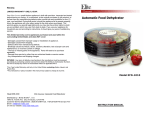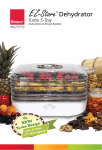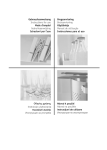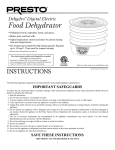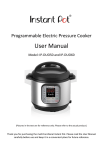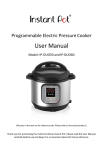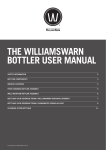Download Elite Products EFD-1010 User's Manual
Transcript
LIMITED WARRANTY* ONE (1) YEAR: Your small kitchen appliance is warranted to the original purchaser to be free from any manufacturing defects under normal use and conditions for one (1) year, cord excluded. During that period, should the appliance fail to operate properly, return the appliance with your sales receipt to the store where purchased. If you use your appliance for household use and according to instructions, it should give you years of satisfactory service. This product warranty covers only the original consumer purchaser of the product. WARRANTY IS ONLY VALID WITH A DATED PROOF OF PURCHASE. To guarantee repair or replacement without charge, a dated sales receipt showing purchase within the limited warranty period* must accompany the appliance. Without a sales receipt, warranty will be estimated according to the appliance's manufactured date. A comparable appliance should arrive within 2-3 weeks. However, in case an appliance is not covered by warranty, correspondence offering alternatives will be mailed to you. During the one-year warranty period, a product with a defect will be either repaired or replaced with a reconditioned comparable model (at our option) when the product is returned to our Service Center. (See the “Returns” section below). The repaired or replacement product will be in warranty for the remaining balance of the one-year warranty period and an additional one-month period. Automatic Food Dehydrator This limited warranty covers appliances purchased and used within the 50 contiguous states plus the District of Columbia and does NOT cover: - Damages caused by unreasonable use, neglect, normal wear and tear, commercial use, improper assembly or installation of product. - Damages caused in shipping. - Damages caused by replacement or resetting of house fuses or circuit breakers. - Defects other than manufacturing defects. - Breakage caused by misuse, abuse, accident, alteration, lack of proper care and maintenance, or incorrect current or voltage. - Lost or missing parts of the product. Parts will need to be purchased separately. - Damages of parts that are not electrical; for example: cracked or broken plastic or glass. - Damage from service or repair by unauthorized personnel. - Extended warranties purchased via a separate company or reseller. - Consumer’s remorse is not an acceptable reason to return a product to our Service Center. *The consumer is responsible for any delivery charges for all replacement units provided for exchange under the warranty. RETURNS: Any return of defective merchandise to the manufacturer must be processed accordingly by contacting customer service first to obtain an RA # (Return Authorization Number). We will not accept any returns of merchandise without an applicable RA #. We cannot assume responsibility for loss or damages to products returned to us during incoming shipment. For your protection, always carefully package the product for shipment and insure it with the carrier. Be sure to enclose the following items with your return: any accessories related to the problem, your full address and daytime phone number, a note describing the problem, a copy of the dated sales receipt or other proof of purchase and a valid RA#. C.O.D shipments cannot be accepted. *One Year Limited Warranty valid only in the 50 contiguous states plus the District of Columbia, excluding Puerto Rico and the Virgin Islands. This warranty is effective only if the product is purchased and operated in the USA; product usage which is in violation of the written instructions provided with the unit will void this warranty. For international warranty, please contact the local distributor. **Any instruction or policy included in this manual may be subject to change at any time. Model EFD-1010 Model EFD-1010 Elite Gourmet Automatic Food Dehydrator Distributed by: MAXI-MATIC , USA 18401 E. Arenth Ave. City of Industry, CA 91748 Customer Service Department: (626) 912-9877 Ext. 116/120 MON-FRI 9am-5pm PCT Email: [email protected] Or visit our website: www.maxi-matic.com ® INSTRUCTION MANUAL IMPORTANT SAFEGUARDS.. When using electrical appliances, basic safety precautions should always be followed as below: 1. Read all instructions carefully. 2. To protect against risk of electrical shock, do not put the base, cord & plug in water or other liquid. 3. Close supervision is necessary when any appliance is used by or near children. 4. Unplug from outlet when not in use, before putting on or taking off parts, and before cleaning. 5. Avoid contact with moving parts. 6. If the supply cord is damaged, it must be replaced by the manufacturer or its service agent or a similar qualified person in order to avoid a hazard. 7. The use of attachments, including canning jars, not recommended or sold by the manufacturer may cause fire, electric shock, or injury. 8. Do not use the appliance out doors. 9. Do not let cord hang over edge of table or counter or contact hot surface, including the stove. 10. Blades are sharp. Be careful not to hurt your hands when detaching and cleaning the blades. 11. To avoid injury, never place cutting blade assembly on base without container properly attached. 12. Do not use appliance for other than intended use. 13. Switch off the appliance before changing approaching parts which move in use (such as container). 14. This appliance has a polarized plug (one blade is wider than the other). To reduce the risk of electric shock, this plug will fit in a polarized outlet, reverse the plug. If it still does not fit, contact a qualified electrician. Do not modify the plug in any way. SAVE THESE INTRUCTIONS THIS PRODUCT IS FOR HOUSEHOLD USE ONLY! PARTS & FEATURES.. POLARIZE PLUG & SHORT CORD SAFETY.. Polarized Plug: This appliance is for Household Use Only. Place it on a level surface, and insert plug into any 120-volt AC electrical outlet. Do not use any other type of outlet. This appliance has a polarized plug (one blade is wider than the other). As a safety feature, this plug fits in a polarized outlet only one way. If the plug does not fit into the outlet, reverse the plug and try again. Do not force the plug into the socket. If it still does not fit, contact a qualified electrician. Do not attempt to defeat this safety feature. Short Cord: A short power-supply cord is provided to reduce the risk resulting from becoming entangled in or tripping over a longer cord. Longer detachable power-supply cords or extension cords are available and may be used if care is exercised in their use. If a longer detachable power-supply cord or extension cord is used, 1) the marked electrical rating of the extension cord should be at least as great as the electrical rating of the appliance, and 2) the longer cord should be arranged so that it will not drape over the counter top or table where it can be pulled on by children or tripped over accidentally. FIRST USE & OPERATION.. BEFORE USING: 1) Carefully unpack the food dehydrator. 2) Wash the five dehydrator trays and lid in warm, soapy water. Rinse well and dry thoroughly. 3) Wipe the dehydrator base with a clean, soft cloth or sponge. NEVER IMMERSE BASE, CORD OR PLUG IN WATER OR ANY OTHER LIQUID. HOW TO USE: 1) Make sure unit is switched OFF and unplugged before using. 2) Always wash the dehydrator trays and lid before each use to avoid any food contamination. 3) Place base on a flat, smooth countertop surface where it will not fall or be pulled by the plug. 4) Prepare food to be dehydrated as instructed in this manual; preparation depends on the type of food. Do not overlap food or overload trays. 5) Arrange food on trays, but do not place trays on the base; stack up the trays first and set them aside. 6) Trays may be adjusted to accommodate a variety of food sizes. 7) Plug unit into electrical wall outlet, switch to ON and preheat for approximately 5 minutes. 8) Place stacked trays onto the base, cover the top tray with the lid, and allow food to dry for the recommended length of time; drying time may vary depending on the type of food. 9) Begin to check on food before the dehydration period is completed; check food for desired dryness. Remove individual pieces and store in containers or food bags. If some pieces are not yet done, leave them on the dehydrator and check frequently until all food dehydration is completed. 10) Food that is not going to be eaten within a day or two should be store in the refrigerator. If store food in the freezer, be sure to use containers or bags designed for freezer storage. 11) Switch the unit OFF and plug after using. 12) Always wash the dehydrator trays and lid after each use. Wipe the base with a soft damp cloth or sponge; do not allow water or any other liquid to get into the base. Make sure the trays and lid are completely dry before replacing them on the base. CLOSING AND OPENING VENTS IN LID: During the first initial hours of dehydrating, leave the vent open to allow moisture to escape. Once the moisture has evaporated from the food that is being dehydrated, you can close the vent and allow the dehydrating process to continue. SELECTING THE TYPE OF FOOD TO DEHYDRATE: Food to be dried should be in good condition. Select fruits that are just ripe; they have the highest natural form of sugar and are best for drying. Fruits that are not ripe may have a flat, bitter taste. Vegetables should be fresh and tender. Check fruits and vegetables for marks or bruises and cut away these portions before preparing for dehydration. Avoid using overripe fruits and vegetables with spoiled portions. Meat, poultry and fish should be fresh and lean. Preparation, dehydration time and storage of foods also influence their quality and taste. Follow the preparation, dehydration and storage instructions in this manual to ensure the best-quality dried foods. WARNING: If you suspect food is contaminated, freeze at 0° for 48 hours to prevent bacteria growth, or heat at 175°F for 15 minutes to pasteurize it. Some nutrition may be lost, but it will stop the contamination process. ** ROLL-UP SHEET The roll-up sheet is for use to dehydrate food that may have drippings that may drip through the holes on the trays. However, it is primarily used to make FRUIT ROLL UPS. Simply mix a mixture of fruits until the consistency is thick and smooth. Pour the mixture over the roll-up sheet to dehydrate for approximately 12 hours. PREPARATION & PRETREATMENT OF VEGETABLES: Vegetables dried at home require a little more effort in processing and storage than do fruits because they are low in acid and have little sugar. Some vegetables have a poor quality when dehydrated, and are better frozen than dried. Others, such as potatoes, are available at reasonable prices all year round, and it may not be worth your time to dry them unless they are used for lightweight camping. Be selective in the vegetables you choose to dry. VEGETABLE DRYING CHART.. VEGETABLE Asparagus Beans (green) Preparation: Select only the highest quality, fresh, crisp and tender vegetables for drying. Wash vegetables carefully just before processing to remove dirt and bacteria. Most vegetables should be peeled, trimmed, cut, or shredded prior to drying. Beets Broccoli Pretreatment: Blanching vegetables prior to drying destroys the enzymes that produce off flavors during storage, resulting in poor texture and poor re-hydration. Steam blanching is preferred over water blanching because there is less flavor and vitamin loss. Microwave blanching is also excellent and usually keeps a brighter color in the vegetables. Steam Blanching: Layer prepared vegetables in the top portion of a steamer, no more than 2 to 2 ½ inches deep. Steam until vegetables are heated all the way through but are not cooked enough to eat (usually 2 to 3 minutes). Small pieces may need occasional stirring to steam blanch evenly. Transfer steamed vegetables directly to drying trays, working as quickly as possible. Microwave Blanching: Microwave ovens are convenient for blanching fresh vegetables. Prepare vegetables as for steam blanching. Place vegetables with small amount of water (refer to your microwave oven cooking chart) in a covered casserole dish. Cook for only ¼ to ⅓the time specified in the chart, stirring well after half of the blanching time. Microwave blanched vegetables will be more brightly colored than those that are steam blanched. Transfer blanched vegetables directly to drying trays, working as quickly as possible. Carrots Corn Celery (Stalks) Celery (Leaves) Chives Cucumber Garlic Mushrooms Onions Peppers (pimentos) Peppers (jalapeños) Potatoes PREPARATION & PRETREATMENT Cut in half to divide tips from stems. Tip are best for drying, but dried stems can be crushed and used for seasoning. Snip off ends and cut as desired. Blanch, then quick freeze for 30-45 minutes. Trim, leaving about an inch of the top and root. Blanch and allow to cool, then cut off the top and root, and slice. Trim and cut as usual. Steam for about 4-5 minutes. Wash and peel. Cut into ½” thick chunks and steam for about 4-5 minutes until tender. Remove husk, wash and steam blanch corn on the cob. Allow to cool, then cut corn from the cob. Wash and separate leaves from stalks. Cut stalks into 1/2” chunks. Place stalks separate from leaves in trays. Break leaves apart from their stems. Place leaves separate from stalks in tray(s). Wash and mince. Wash, trim and slice about ¼” thick. Separate and peel cloves. Cut cloves in halves or slice. Brush clean and remove stem. Leave whole, cut in halves or slice. Trim ends and peel. Cut in rings or dice. Wash and remove core. Cut in halves, quarters, rings or strips. Wash and dry whole. ESTIMATED TIME 17-19 hours 17-19 hours 22-24 hours 17-19 hours 11-13 hours 8-10 hours 12-14 hours 6-8 hours 5-7 hours 11-13 hours 16-18 hours 11-13 hours 13-15 hours 13-15 hours 11-13 hours Wash and peel. Cut or slice as desired 14-16 hours and steam blanch. Rinse under cold water and pat dry before placing on tray(s). Note: If you wish to leave the skin on the potatoes, wash and scrub with vegetable cleaning brush, then prick and remove all “sprouts” and “scars,” using the tip of a potato peeler or paring knife. Tomatoes Wash and remove stems. Dip in boiling 18-20 hours water and then in cold water. Remove skin and cut in halves, quarters or thick slices. *Approximate times are offered as guidelines only. Drying time may vary, depending on quality and quantity of vegetables being dried. PREPARATION & PRETREATMENT OF FRUITS: Almost all fruits are suitable for drying at home, but some fruits will require more drying time than others; the guidelines offered in this manual will help you get started. Some fruits might not be suitable for drying all year round, so it will be helpful to learn which fruits are in season and experiment with those first. Preparation: Wash fruits well and remove any bruised or overripe portions. Peel if desired. Larger fruits may be halved. If pieces of fruit vary in size, they may be sliced 3/8” to ½” thick for more even drying. Smaller fruits such as grapes and cherries may be dried whole. Remove pits or stones from fruits such as prunes, cherries, apricots, etc. Fruits that have been artificially waxed to prevent moisture loss should always be peeled. Peeling is optional with other fruits. Dried pear skins tend to be grainy, and peach peels are a little fuzzy. Most fruits can be placed directly on the drying rays as they are prepared…pineapples, grapes, strawberries, prunes, etc. However, apples apricots, peaches and pears turn brown when the cut surface are exposed to the air, due to oxidation and the continuous reaction of enzymes, these fruits may be pretreated to slow this browning and to prevent loss of vitamins A an C, but your attention is called to the cautions set forth below, which are for your protection. If you are drying these fruits, and you intend to pre-treat them, cut pieces can be prevented from browning while they are being prepared by keeping them in a holding solution until you have sufficient fruit to pre-treat. Pretreatment: Below are listed several optional methods of pretreatment. You need not pre-treat food in order to dry it. However, pretreatment often makes food look better, increases the shelf life and can even enhance the nutritional value of some foods. Experiment with both treated and untreated food in your storage to see which will best suit your needs. Remember, proper storage is critical to the quality of the stored product, whether treated or untreated. Natural Pre-Dips: Use pineapple or lemon juice as a natural alternative to other pretreatments to reduce browning. Slice fruit directly into juice. Remove promptly (about 2 minutes) and place on trays. Fruits may also be dipped in honey, spices, lime or orange juice, jello powders or sprinkled with coconut to give them a snappy dried flavor. Use your imagination and make your own flavorful dip. Sodium Bisulfite: Ask for food-safe, (USP) grade only. Dissolve 1 teaspoon of sodium bisulfite in one quart of water. Prepare small amounts of fruit and dip for 2 minutes in the solution. This helps prevent loss of vitamin C and maintains a bright color. Sodium bisulfite is available in most pharmacy/drug stores. Popping Backs: When drying fruit halves, especially apricots, it has been suggested that popping the back (“inside out”) will speed the drying time. This is true, but it also results in the loss of the nutritional juices to the bottom of the dehydrator. Instead, cut each half in half again to give the end product more nutritional value, a brighter color, and faster reconstitution capabilities. FRUIT DRYING CHART.. FRUIT Apples PREPARATION & PRETREATMENT Wash, and peel if desired. Cut in halves and remove core, then cut into chunks or slice. Can be pretreated with a little lemon juice to prevent browning. ESTIMATE TIME 22-24 hours Apricots Wash, cut in halves and remove pit. Cut further into quarters, if desired. 30-35 hours Bananas Peel and slice. Can be pretreated with a little lemon juice to prevent browning. 22-24 hours Cherries Wash and remove pit 22-24 hours Coconut Drain milk, crack and remove coconut. Pat dry and cut into ¼” thick chunks. 24-30 hours Figs Wash and remove stems. Cut into halves or quarters (dry skin side up) 22-24 hours Grapes Wash and remove stems. Leave whole. 23-25 hours Papaya Wash and peel. Cut into large or small chunks, as desired. 30-35 hours Peaches Wash, cut in halves and remove pit. Cut further into quarters, if desired. 35-42 hours Pears Wash, and peel if desired. Cut in halves and remove core, then cut into chunks or slices. Can be pretreated with a little lemon juice to prevent browning. 28-32 hours Pineapple Remove core and cut into chunks, or slice into wedges. 22-25 hours Prunes Wash, cut in halves and remove pit. Cut further into quarters, if desired. 30-35 hours Strawberries Wash and leave whole, cut in halves or slice. 12-15 hours *Approximate times are offered as guidelines only. Drying time may vary, depending on quality and quantity of fruits be dried. MEAT DRYING PREPERATION.. Normally raw meat is used for making jerky. However, cooked meat as well as raw meat can be dehydrated. Make sure to always cut meat down to bite size before dehydration. It is much easier to work with beforehand. Be extra careful when making jerky from raw chicken or turkey because salmonella bacteria may be present in poultry when it is purchased. It is extremely important to cut raw chicken or turkey into portions that do not exceed 1/4" thickness. Any marinade must thoroughly penetrate and soak into the meat, up to 10 minutes or more. It is not recommended to remove any excess marinade sauce. Never consume food that tastes, smells or looks improper. RAW MEAT FOR BEEF JERKY: Any kind of beef is good for making beef jerky. Make sure to trim off all the fat before slicing into bite-size portions. It is recommended to slice meat about 1/8" - 1/4" thickness. Marinating beef has many different combination recipes. Please see some recipe samples below for your preference: TRADITIONAL JERKY: (Good for approximately 3-5 lbs of beef, fish, or poultry) ½ lb brown sugar 3 cups soy sauce *Spices of your choosing ½ cup liquid smoke (optional) Mix all ingredients together. Make sure the brown sugar is dissolved. Let mixture sit for approximately 15 minutes. Place cut up meat into the marinade and cover. Let stand for 10 minutes refrigerated. Make sure to turn meats periodically to coat thoroughly. Drain any excess liquid. Place meats onto trays and dehydrate. Drying time for a full 5-tray set up will take approximately 24-36 hours. OTHER DRYABLE ITEMS.. NUTS: Remove shells to the nuts and rinse nuts with warm water. Pat dry and spread on trays. Most nuts will take approximately 20-30 hours to dehydrate; they should be allowed to dehydrate until brittle. After dehydrating, allow to cool. Nuts that will not be consumed within a day or two should be frozen to ensure freshness. Remove nuts from the freezer and allow them to defrost before using. HERBS: Rinse and pat dry. Remove any dead, mushy or discolored portions, but leave the stem and do not break apart until drying. Spread herbs or flowers on tray and allow to dehydrate for about 2-7 hours, depending on their type. When drying is complete, remove from tray and allow to cool. Remove from stem and break leaves or buds apart, or crush if desired. If dehydrating seeds, choose when pods have changed in color. FLOWERS: For best results, pick flowers after the morning dew rises and before the evening mist sets in. Do not use flowers that have been sprayed with insecticides or other harmful chemicals. If dehydrating at the same time as herbs intended for consumption, place flowers on the bottom trays and herbs on the top trays; this is to prevent any “drippings” from the flowers to fall onto the herbs. HELPFUL HINTS.. - - Always preheat the dehydrator for at least 5 minutes before using. If the dehydrator has been stored away for some time, wash and clean before using. Fresh vegetables and fruits are best for dehydrating. Canned goods to not dehydrate as well. Vegetables and fruits should always be cleaned before preparation and pretreatment. For best results, always prepare and pre-treat fruits and vegetables as outlined in this manual. It is relatively safe to leave the dehydrator on when dehydrating foods take a long time, but make sure to set the dehydrator in a safe place. Read the “Important Safeguards” on page 1 of this manual, and exercise safety when using this product. Exact dehydrating time varies greatly depending on several factors: Type, size and quality of food, quantity placed on trays and personal preference. It will help to keep a personal notepad where you can write down your own notes. Keep notes on the type of food, weight before and after drying, total drying time and final results FOOD STORAGE.. Packaging: DRIED FOODS MUST BE PROPERLY PACKAGED IN ORDER TO KEEP WELL. Package your dried foods in freezer plastic bags, squeezing out as much air as possible. Heat-sealable bags may also be used. Store the plastic bags inside of airtight metal, plastic or glass containers. Storing foods in rigid containers without first putting them into the freezer bags exposes the dried foods to air. Vacuum packaging equipment for home use is available in some stores around the country. Vacuum packaging will greatly extend shelf life. Storage Conditions: Store properly packaged dried foods in a cool, dark place. The cooler the food is kept, the longer the optimal quality will be maintained. For every 18°F drop in temperature, the shelf life increases 2 to 3 times. If you have room in a refrigerator or freezer, keep your dried foods there. Otherwise, find the coolest place in your home to store dried foods. Light also causes the quality and nutritive value to deteriorate. Keep dried foods in the dark or in opaque containers. Shelf Life: Fruits have a naturally high sugar and acid content, which allows them to dry well and store for longer periods of time than vegetables. When properly packaged and stored at room temperature or below (70°F or less), most fruits will maintain a high quality and nutritional value up to a year. Most vegetables are best when eaten within six months. FRUITS AND VEGETABLES KEPT BEYOND THE RECOMMENDED TIME MAY NOT BE AS NUTRITIOUS OR TASTE AS GOOD BUT WILL NOT SPOIL UNLESS THE PACKAGING IS NO LONGER INTACT. MAINTENANCE.. This appliance requires little maintenance. It contains no user serviceable parts. Do not try to repair it yourself. Refer it to qualified personnel if servicing is needed. Always unplug the dehydrator from electrical outlet when not in use and before cleaning. TO CLEAN: NEVER IMMERSE BASE (MOTOR HOUSING) IN WATER. First, be sure unit is switched “OFF” and unplugged. Separate trays from the base. Wash trays and lid with warm, soapy water, using a soft cloth or sponge. Rinse well and dry thoroughly. Wipe base (motor housing) with a slightly damp cloth or sponge. DO NOT use scouring pads or any type of harsh cleanser to clean the Dehydrator, as this may damage the finish. TO STORE: Unplug unit; store in its box in a clean, dry place. Never store it while it is hot or still plugged in. Never wrap cord tightly around the appliance. Do not put any stress on the cord where it enters the unit, as it could cause the cord to fray and break.







